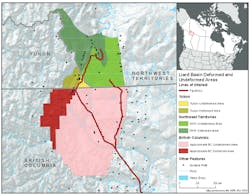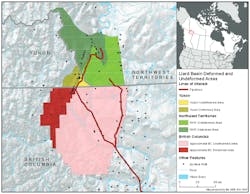Study: Canada’s Liard basin among world’s largest shale gas resources
The Liard basin in northwest Canada is expected to contain 219 tcf of marketable, unconventional gas, according to a study from five Canadian entities.
The findings were a collaborative effort of Canada’s National Energy Board (NEB), the British Columbia Oil & Gas Commission, the Yukon Geological Survey, the Northwest Territories Geological Survey, and the British Columbia Ministry of Natural Gas Development.
The study compares Liard’s marketable potential to that of the Montney formation, which has been estimated at 449 tcf; and the Horn River basin, estimated at 78 tcf. Total Canadian natural gas demand in 2014 was 3.2 tcf, making the Liard basin gas resource equivalent to 68 years of Canada’s 2014 consumption.
“However, it is too early to know whether the Liard basin will significantly contribute to Canadian gas production in the near term because gas prices are expected to remain low for the next several years, deterring development,” the study notes.
“Although additional in-place gas potential is found in the Horn River shales of the Liard basin, it is uncertain whether any is technically recoverable,” it says.
Gas pipelines are present in all three jurisdictions of the basin because of conventional wells that have been producing from Beaver River field in BC since the late 1960s, the Pointed Mountain field and other gas fields in the NWT since the early 1970s, and the Kotaneelee field in Yukon since the late 1970s.
Canada has more than 850 tcf of remaining, marketable gas in areas already served by major pipeline systems. This is the equivalent of 267 years of supply based on Canada’s 2014 consumption rate, the study says.

